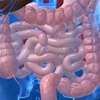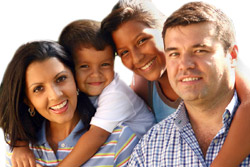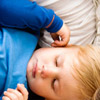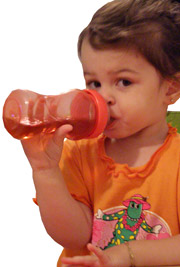- Toilet training (potty training)
- When should I start toilet training?
- How do I know if my child is ready to be toilet trained?
- How should I start toilet training?
- Dealing with set backs
- Where to get help
Toilet training (potty training)
Toilet training is an important developmental milestone and can be a challenging step for both parents and toddlers. A child is considered fully toilet trained when they are conscious of the fact that they need to pass urine or open their bowels and can take themselves to the toilet without reminders from their parents.
A child’s ability to use a toilet or potty is influenced by gender, race, culture, socioeconomic status and the temperament of the child. There is considerable variation in potty training techniques across different generations and cultures. In most countries the age at which toilet training is achieved is increasing, possibly due to the introduction of disposable nappies. In 1947, 60% of children were toilet trained by the age of 18 months, whereas in 2003 this wasn’t achieved until 36.8 months.
Girls generally complete toilet training at an earlier age than boys. This is thought to be due to the fact that girls are more influenced by socialisation and that boys must adopt different postures for toileting depending on whether they are doing a wee or a poo. One study found that the average age for staying dry during the day was 32.5 and 35 months for girls and boys respectively. A separate study found that 24.3% of 2 year olds were out of diapers during the day versus 8.6% being out of diapers at night. Night-time dryness is generally achieved by 5 years of age; however, it is important to remember that 20% of 5 year olds still wet their bed.
 |
For more information about the different sections of the gastrointestinal system and their functions, see Gastrointestinal System. |
 |
For more information about how urine is produced and regulated in the body, see Urinary Tract. |
When should I start toilet training?
As each child and family is unique the ideal age to start toilet training will differ from one child to the next. Starting too early will only cause frustration for you and your child. Starting too late is associated with increased cost of nappies, robs toddlers of their independence and limits enjoyment of social activities. In addition, there are health risks associated with delayed toilet training which include urinary tract infections, bladder dysfunction, constipation and contracting diarrhoea or hepatitis A from change facilities.
Toilet training is complex and involves several steps including being able to walk to and from a toilet/potty, sitting on a toilet/potty, doing a wee or poo, pulling pants down and back up, flushing the toilet and washing hands. As a general rule of thumb, toilet training should start between 18 months and 3 years of age. Your health practitioner should discuss toilet training with you at your child’s 18 month check up.
There appears to be a relationship between when toilet training is started and how long toilet training takes. One study which looked at early versus late initiation found that training which began before 24 months of age resulted in 68% of toddlers being fully toilet trained by 36 months of age. Only 54% of children who began training after 24 months were fully trained by the same age. However, the time taken to toilet train a child is longer when toilet training is started earlier.
How do I know if my child is ready to be toilet trained?
Some signs that your child may be ready to begin toilet training include:
- Not needing to do a poo overnight;
- The ability to pull training pants up and down;
- Staying dry for longer periods (> 2 hours) during the day and waking up dry from day time sleeps;
- Your toddler passes regular and soft poos;
- Your toddler can indicate with words or actions that they need to do a poo or wee;
- Your toddler can follow simple instructions;
- Your toddler is uncomfortable in wet or pooey nappies and is able to indicate this;
- Your toddler expresses curiosity in watching others go to the toilet;
- Your toddler is able to sit in one position for 2–5 minutes.
How should I start toilet training?
From 12 months onwards it is appropriate to discuss toileting with your toddler. Children will naturally be interested in watching others use the toilet and this should be encouraged. Another helpful tool to engage your toddler in toilet training is the use of potty training books. There are many books on this subject available through bookstores and your local library. Parents should use simple terminology like “poo” and “wee” and avoid negative words like “stinky” and “yucky” which may dissuade the toddler and make them self-conscious.
A potty seat with support for the toddler’s feet is ideal and encourages correct posture and technique. Potties that are too low and require a toddler to squat cause increased pressure when doing a wee. A standard adult toilet that is too high encourages tightening of the thigh muscles and stops relaxation of the pelvic floor muscles.
At around 18 months a toddler can be put into training pants. Continue using nappies overnight and for long car trips or longer outings. Passing of poo into a potty is generally achieved before passing urine. Try putting the toddler on the potty at the time that they usually do a poo if this is predictable. Once the toddler has successfully done a poo into the potty on 2–3 occasions, they can be placed on the potty every 2–3 hours or asked whether or not they need to use the toilet at regular intervals.
Positive acknowledgement of a successful poo or wee into the potty is encouraged. Once the child is successfully using the potty teach him/her to wipe their bottom and wash their hands. Once daytime dryness is achieved, the next step is using training pants overnight until night time dryness is achieved.
Dealing with set backs

Accidents
Accidents are a natural part of toilet training and will happen even once your child is toilet trained. When accidents occur it is best to clean the child up and to keep fuss and negativity to a minimum. Reassure your child that accidents don’t matter and that it takes time to master the skill of using the potty. Punishment has no role in potty training. It is best to carry a spare change of clothes at all times.
My child refuses to use the potty
One in five children will go through a period where they refuse to go to the toilet. This behaviour can be associated with delayed toilet training, constipation and an increased risk of encopresis. If your toddler refuses to use the potty don’t force the issue and try again in a month’s time.
What do I do during times of illness and stress?
It is best to avoid initiating toilet training during times of illness and stress, including the arrival of a new baby. If your child becomes ill during the toilet training period it is best to stop toilet training until he/she is better and then start again.
Constipation
Bedwetting and constipation are closely related with 7 to 70% of children who wet the bed experiencing constipation. Constipation can aggravate bed wetting through retained stools in the rectum compressing the bladder. This in turn reduces the capacity of the bladder, triggering an early desire to pass urine. In addition, hard stools within the rectum can cause spasm of the pelvic floor muscles which prevents them from relaxing when urine needs to be passed, leading to retained urine in the bladder.
Your doctor will be able to advise you on how to best manage your child’s constipation. A variety of different tactics including addressing incorrect toileting habits, increasing fibre in your child’s diet and the correct use of laxatives as may be used.
Bed wetting
Bed wetting (also known as enuresis) refers to intermittent bed wetting that occurs at night but may be associated with episodes of wetness during the day in children over the age of 5 years. Bed wetting is a common problem affecting 20% of 5 year olds, 10% of 10 year olds and 3% of 15 year olds. It has a significant impact on both the child that wets their bed and their family.
 |
For more information about the causes of bed wetting view the video: Causes of Bedwetting. |
There are many treatment options available for children who wet their bed. Your doctor will decided which treatment is best for your child after excluding other medical problems which can cause bed wetting.
If your child has been dry for a period of 6 months and then starts to wet themselves again, this might be a sign of an underlying health problem. If the wetting continues it is important to see your local medical practitioner for further assessment.
 |
View a video of Paediatrician Dr Mark Gibbeson discussing options for treating bedwetting in children. |
 |
For more information about what causes bed wetting and how it can be treated, see Nocturnal Enuresis (Bed Wetting). |
Where to Get Help
There are several avenues of help for parents who want advice on toilet training or who are experiencing difficulties;
- Toilet training books available through local library. Most parenting books will have a section on toilet training;
- Your local child health centre;
- Your local doctor;
- Local community enuresis clinic (generally requires a referral from your child health nurse or GP).
References
- Mota D, Barros A. Toilet training: situation at 2 years of age in a birth cohort. Journal of Paediatricics. 2009; 84: 455-462. [Full Text]
- Schum T, Kolb T, McAuliffe T et al. Sequential acquisition of toilet training skills: a descriptive study of gender and age differences in normal children. Pediatrics. 2002; 109: E48. [Abstract | Full Text]
- Choby B, George S. Toilet training. American Family Physician. 2008; 78: 1059-1064. [Full Text]
- Schonwald A, Sherritt L, Stadtler A et al. Factors associated with difficult toilet training. Pediatrics. 2004; 113: 1753-1757. [Full Text]
- Lang M. Among healthy children, what toilet-training strategy is most effective and prevents fewer adverse events (stool withholding and dysfunctional voiding)? Paediatric Child Health. 2008; 13: 203-204. [Full Text]
- Brazelton T, Christophersen E, Frauman A. Instruction, timeliness and medical influences affecting toilet training. Pediatrics. 1999; 103: 1353-1358. [Full Text]
- Mota D, Barros A. Toilet training: methods, parental expectations and associated dysfunctions. Journal de Pediatria. 2008; 84: 9-17. [Abstract | Full Text]
- Barker, R. The mighty toddler: the essential guide to the toddler years. Sydney: Pan Macmillan Australia; 2009.
- Bower F, Moor K, Shepherd R et al. The epidemiology of enuresis in Australia. British Journal of Urology. 1996; 78: 602-606. [Abstract]
- Toilet Training. American Family Physician. 2008; 78: 1066. [Full Text]
- McGrath K, Caldwell P, Jones M. The frequency of constipation in children with nocturnal enuresis: a comparison with parental reporting. Journal of Paediatrics and Child Health. 2008; 44: 19-27. [Abstract]
- Afzal N, Tighe M, Thomson M. Constipation in children. Italian Journal of Pediatrics. 2011; 37: 28. [Full Text]
- Neveus T, Von Gontard A, Hoebeke P et al. The standardization of terminology of lower urinary tract function in children and adolescents: report from the standardisation committee of the International Children’s Continence Society. The Journal of Urology. 2006; 176: 314-324. [Abstract | Full Text]
- Schulpen T. The burden of nocturnal enuresis. Acta Paediatrica. 1997; 86: 981-984. [Abstract]
- National Institute for Health and Clinical Excellence. NICE clinical guideline 111 – Nocturnal Enuresis: the management of bedwetting in children and young people. Issue date October 2010. Available from URL: [URL Link]
- Neveus T, Eggert P, Evans et al. Evaluation and treatment of monosymptomatic enuresis: a standardisation document from the international children’s continence society. The Journal of Urology. 2010; 183: 441-447. [Abstract | Full Text]
All content and media on the HealthEngine Blog is created and published online for informational purposes only. It is not intended to be a substitute for professional medical advice and should not be relied on as health or personal advice. Always seek the guidance of your doctor or other qualified health professional with any questions you may have regarding your health or a medical condition. Never disregard the advice of a medical professional, or delay in seeking it because of something you have read on this Website. If you think you may have a medical emergency, call your doctor, go to the nearest hospital emergency department, or call the emergency services immediately.









